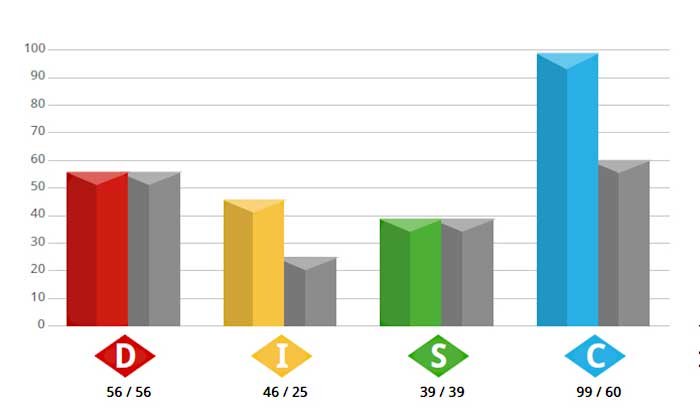When you look at a DISC personality assessment report like the one pictured below, you see each category has 2 scores associated with it.

disc assessment natural behaviors
The colored bar indicates our natural behavior, or how we act when we don’t think about the way we are acting. This is represented by the ‘natural graph’. The gray bar designates our adaptive style preferences, or how we act when we perceive the need to change our behavior due to outside influences. This is represented by the ‘adapted graph’.
Out of all the personality assessments, the DISC profile stands out for its ability to differentiate between a person’s Natural and Adaptive behaviors. These differences are pivotal for individuals and organizations aiming to harness these insights for personal growth and team dynamics.
Natural DISC Scores:
These scores reflect an individual’s natural style — how they naturally react in comfortable environments without the pressure to conform or adjust. The natural graph shows an individual’s inherent behavior and preferences, highlighting the distinction between their preferred behaviors and how they adapt in different situations. This aspect of the DISC assessment reveals the inherent traits that an individual consistently exhibits, offering a window into their stable behavioral tendencies over time.
Adaptive DISC Scores:
In contrast, Adaptive DISC scores demonstrate how individuals modify their behavior in response to their perceived demands of a situation or environment, showcasing their adapted style. Adapted graphs illustrate an individual’s behavioral styles and their ability to adapt in various situations. This score is crucial in understanding how someone adjusts their natural tendencies to meet external expectations or challenges, which can be particularly useful in professional settings where adaptability and flexibility are prized.
Why Both DISC Scores Matter:
Together, Natural and Adaptive DISC scores provide a dual perspective on behavior that is critical for understanding both natural and adapted styles. Analyzing both natural and adapted graphs is essential for a comprehensive understanding of a person’s behavior, as it visually represents an individual’s behavioral style and adaptations in various situations. While the Natural score offers a baseline of behavior, the Adaptive score reveals how effectively an individual can stretch beyond their comfort zone — a key factor in personal development and effectiveness in diverse situations.
Applications of DISC Scores in Real Life:
For professionals, understanding the gap between these scores can help structure job responsibilities to align with individual behavioral styles. It can also aid in creating development plans tailored to individual adaptability, leveraging insights from Natural and Adapted graphs to enhance understanding of an individual’s behavior. It can aid in recognizing when an individual is under stress (as indicated by a significant deviation from their Natural score) or when they are effectively adapting to new challenges.
Conclusion:
By exploring both Natural and Adaptive DISC scores, we gain a complete picture of a person’s behavioral style through the different attributes that DISC measures. The DISC questionnaire is used to assess various personality traits and generate insights into an individual’s behavioral tendencies and adjustments. This knowledge not only enhances self-awareness but also improves interpersonal interactions in both personal and professional contexts.



